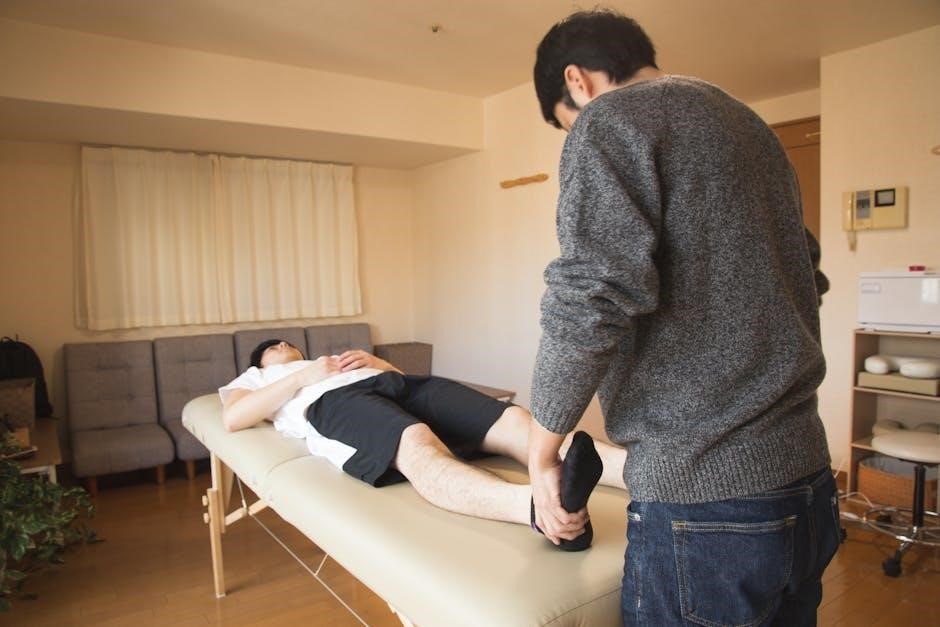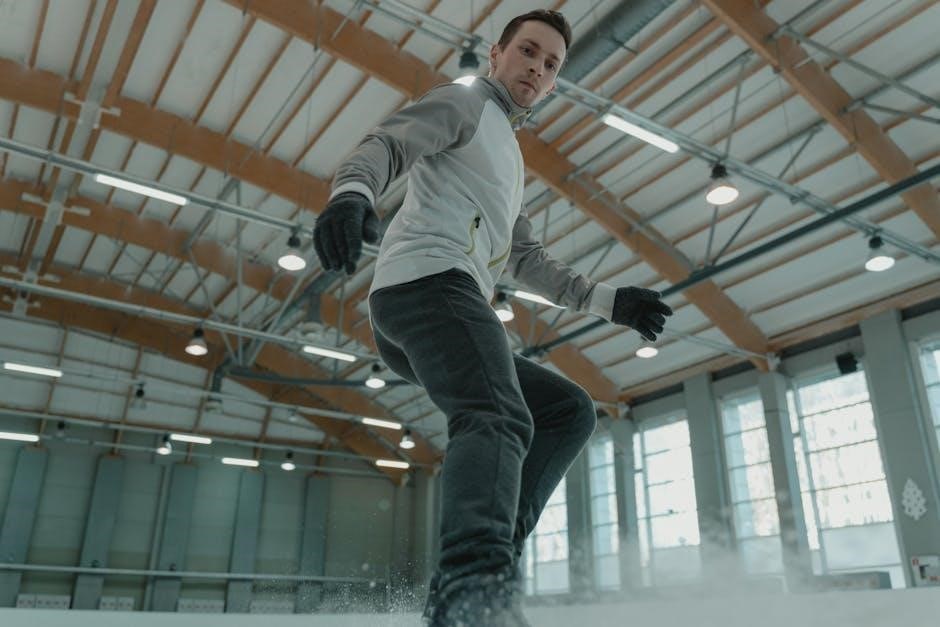Sciatica is a condition causing pain along the sciatic nerve, radiating from the lower back to the legs. Common symptoms include tingling, numbness, and weakness. It often results from nerve compression, typically due to a herniated disc or spinal stenosis. Physiotherapy exercises, such as the Piriformis Super Stretch and Lying Glute Stretch, are effective in alleviating symptoms and improving mobility.
1.1 Understanding Sciatica
Sciatica refers to pain caused by irritation or compression of the sciatic nerve, which runs from the lower back to the legs. It is not a diagnosis but a symptom of an underlying issue, such as a herniated disc or spinal stenosis. The condition often results in discomfort, numbness, or tingling in the lower back and legs, impacting daily activities and mobility.
1.2 Common Symptoms and Triggers
Common symptoms of sciatica include lower back pain radiating to the legs, numbness, and tingling. Triggers often involve prolonged sitting, poor posture, or sudden movements that compress the sciatic nerve. These symptoms can significantly impact daily activities, making it essential to address both the causes and the discomfort through targeted exercises and lifestyle adjustments.

The Role of Physiotherapy in Managing Sciatica
Physiotherapy plays a crucial role in managing sciatica by relieving pain, improving mobility, and strengthening muscles. Exercises like Piriformis Super Stretch and Lying Glute Stretch are effective.
2.1 Benefits of Physio Exercises
Physio exercises for sciatica provide numerous benefits, including pain relief, improved flexibility, and enhanced muscle strength. They target the sciatic nerve and surrounding muscles, reducing inflammation and promoting healing. Regular practice can restore mobility, prevent future flare-ups, and improve overall quality of life by addressing the root causes of sciatica discomfort effectively and safely.
2.2 How Physiotherapy Addresses Sciatica
Physiotherapy targets the root causes of sciatica by reducing nerve compression and inflammation. It strengthens core and gluteal muscles, improves posture, and enhances flexibility. Specific exercises like nerve glides and stretches help restore normal nerve function and movement. Physiotherapy also promotes long-term recovery by addressing muscle imbalances and improving joint mobility, ensuring sustainable pain relief and preventing recurrence.
Types of Physio Exercises for Sciatica
Physio exercises for sciatica include stretching, strengthening, and rehabilitation routines. These exercises target pain relief, improve flexibility, and enhance muscle strength, promoting overall recovery and mobility effectively.
3.1 Initial Rehabilitation Exercises
Initial rehabilitation exercises for sciatica focus on gentle stretches and low-intensity movements to ease pain and improve mobility. These include knee-to-chest stretches, pelvic tilts, and bridging exercises. These exercises help reduce inflammation, strengthen core muscles, and promote proper posture without overexertion, laying the foundation for more advanced routines as the patient progresses in their recovery journey.
3.2 Advanced Strengthening Exercises
Advanced strengthening exercises for sciatica target core muscles, glutes, and hamstrings to improve stability and reduce nerve compression. Exercises like glute bridges, side-lying leg lifts, and hip abductions are commonly recommended. These movements enhance muscle endurance and promote proper spinal alignment, helping to prevent future flare-ups. They should be performed with controlled movements and gradually increased intensity to avoid aggravating the condition.
3.3 Stretching Exercises for Sciatica Relief
Stretching exercises are essential for sciatica relief, targeting tight muscles like the piriformis, hamstrings, and hip flexors. The Piriformis Super Stretch and Lying Glute Stretch are effective in reducing nerve compression. These exercises improve flexibility, alleviate pain, and promote healing. Regular practice helps restore range of motion and prevents muscle imbalances that contribute to sciatica symptoms.

When to Start Physio Exercises
Begin physio exercises for sciatica when pain is manageable, typically after acute symptoms subside. Consult a healthcare professional for a readiness assessment to ensure safety and effectiveness, especially if underlying conditions like herniated discs exist. Start with gentle exercises, gradually increasing intensity to avoid overexertion and prevent worsening symptoms.
4.1 Assessing Readiness for Exercise
Assessing readiness involves evaluating pain levels, mobility, and medical clearance. A healthcare professional can determine if acute symptoms have subsided enough for safe exercise. Initial exercises focus on pain reduction and improving flexibility, such as gentle stretches like the Piriformis Super Stretch. Monitoring progress ensures exercises are adjusted to individual needs, preventing overexertion and promoting recovery. Regular check-ins with a physiotherapist optimize outcomes.
4.2 Guidelines for Beginning a Routine
Start with low-intensity exercises like gentle stretching and strengthening. Perform exercises 2-3 times daily, focusing on proper technique. Begin with short sessions, gradually increasing duration as tolerance improves. Incorporate exercises such as the Lying Glute Stretch and Hip Flexor Exercise to target specific areas. Avoid activities that exacerbate pain and maintain consistent communication with your physiotherapist for adjustments and guidance.

Safety Tips and Precautions
When performing physio exercises for sciatica, prioritize proper form to avoid injury. Modify exercises based on pain severity and gradually increase intensity to prevent overexertion.
5.1 Modifying Exercises Based on Severity
Adjust exercises according to pain levels and mobility. For acute cases, focus on gentle stretches like the Piriformis Super Stretch and Lying Glute Stretch. As symptoms improve, gradually introduce strengthening exercises such as glute bridges and hip flexor exercises. Always consult a physiotherapist to tailor routines to individual needs and avoid aggravating the condition.
5.2 Avoiding Overexertion
Overexertion can worsen sciatica symptoms, so it’s crucial to balance activity and rest. Start with low-intensity exercises, gradually increasing difficulty. Avoid high-impact activities that strain the lower back. If pain persists or intensifies, stop the exercise immediately and consult a physiotherapist to modify the routine and ensure a safe recovery process.

Preventing Future Sciatica Flare-Ups
Maintaining proper posture, engaging in regular exercise, and managing weight are key to preventing sciatica recurrence. Strengthening core muscles and improving flexibility reduce nerve compression risks effectively.
6.1 Maintaining Proper Posture
Maintaining proper posture is crucial for preventing sciatica flare-ups. Sitting and standing with spinal alignment reduces nerve pressure. Regular core-strengthening exercises and ergonomic adjustments help promote good posture, minimizing strain on the lower back and sciatic nerve. This proactive approach can significantly reduce the risk of future episodes and improve overall spinal health effectively.
6.2 Regular Exercise and Activity
Regular exercise strengthens muscles, improving spinal stability and reducing sciatica risk. Low-impact activities like swimming and cycling are ideal, while stretching exercises, such as the piriformis and hip flexor stretches, enhance flexibility. Consistency in these routines helps maintain nerve mobility and prevents future flare-ups, promoting long-term relief and overall well-being effectively through sustained physical activity.
6.3 Weight Management
Maintaining a healthy weight reduces pressure on the spine and sciatic nerve, lowering the risk of sciatica. A balanced diet combined with regular exercise helps manage weight effectively, promoting overall spinal health and preventing future episodes of pain and discomfort through sustainable lifestyle choices.

Key Stretches for Sciatica Pain
Key stretches for sciatica pain include the Piriformis Super Stretch, Lying Glute Stretch, and Hip Flexor Exercise. These exercises target the sciatic nerve, reducing discomfort and improving mobility.
7.1 Piriformis Super Stretch
The Piriformis Super Stretch targets the piriformis muscle, which often compresses the sciatic nerve. Lie on your back, bend one knee towards your chest, and cross the ankle over the opposite knee. Gently pull the unaffected leg toward your chest until a stretch is felt in the buttock. Hold for 20-30 seconds and repeat 2-3 times to relieve tension and reduce sciatica pain effectively.
7.2 Lying Glute Stretch
For the Lying Glute Stretch, lie on your back with knees bent and feet flat. Cross one ankle over the opposite knee, then gently pull the unaffected leg toward your chest until a stretch is felt in the buttock. Hold for 20-30 seconds and repeat 2-3 times to relieve sciatica pain and improve hip flexibility.
7.3 Hip Flexor Exercise
Lie on your back with knees bent and feet flat. Gently bring one knee toward your chest, holding onto your thigh. Stretch is felt in the hip flexor and lower back. Hold for 20-30 seconds, then lower slowly. Repeat 2-3 times on each side. This exercise helps reduce sciatica discomfort by improving hip flexor flexibility and relieving nerve tension.

Real-Life Examples of Exercise Routines
Examples include morning routines with Glute Bridge and Piriformis Super Stretch, followed by evening stretches like Lying Glute Stretch. Consistency is key for relief and mobility.
8.1 Sample Morning Routine
A gentle morning routine might begin with a 10-minute warm-up, followed by the Piriformis Super Stretch and Lying Glute Stretch to improve flexibility. Incorporate the Glute Bridge to strengthen the lower back and glutes, and finish with seated or standing stretches to enhance mobility. Perform each exercise 2-3 times, holding stretches for 20-30 seconds. Consistency aids in reducing stiffness and pain.
8.2 Evening Stretching Routine
End your day with a calming routine to relieve tension. Begin with the Piriformis Super Stretch, holding for 30 seconds per side. Follow with a gentle Hamstring Stretch and Cat-Cow Spinal Mobility exercise to enhance flexibility. Conclude with deep breathing to promote relaxation. Perform each stretch 2-3 times, focusing on slow, controlled movements to avoid overexertion and ensure a restful night’s sleep.
Physiotherapy effectively manages sciatica through targeted exercises like Piriformis Super Stretch and Lying Glute Stretch. Consistency is key for long-term relief and improved mobility. Stay committed to your routine and consult a physiotherapist for personalized adjustments to achieve optimal results and prevent future flare-ups.
9.1 Summary of Benefits
Physiotherapy exercises for sciatica offer significant benefits, including reduced pain, improved mobility, and strengthened muscles. Techniques like the Piriformis Super Stretch and Lying Glute Stretch enhance nerve flexibility and alleviate discomfort. Regular practice promotes long-term relief, enabling individuals to resume daily activities with ease. Consistency in exercise routines is crucial for sustained improvement and overall well-being.
9.2 Encouragement for Consistency
Consistency is key to achieving long-term relief from sciatica symptoms. Regular physiotherapy exercises, such as the Piriformis Super Stretch and Lying Glute Stretch, strengthen muscles and improve flexibility. Stay committed to your routine, even if progress is gradual. Over time, these exercises will help reduce pain and enhance mobility, ensuring a better quality of life.




About the author